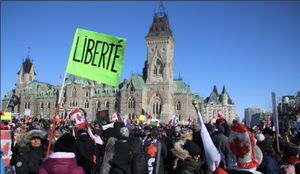Delhi finds itself shrouded under thick smog this Diwali, with air quality reaching disastrous levels. Despite longstanding bans on firecrackers aimed at curtailing the toxic haze, the festival of lights still came with its share of air pollution. Diwali, celebrated on October 31 this year, is typically marked by colorful fireworks, but increasingly, it has also become synonymous with slides in air quality. This year’s pollution levels are alarming, showing little regard for public health as the city grapples with the consequences of festive celebrations against the backdrop of air quality rules.
On the eve of Diwali, it seemed like Delhi was slipping back from the relative clarity observed during last year's festivities. Data from the Central Pollution Control Board indicated the city's 24-hour Air Quality Index (AQI) soared to 328 by 4 p.m., categorizing it as 'very poor'. This stands as stark evidence against the backdrop of Chhoti Diwali when the AQI was recorded at 307. Every year, Delhians look forward to Diwali, yet they also dread the aftermath— the suffocative smog lurking right after, as pollution levels rise sharply.
Local authorities have struggled to maintain the ban on firecrackers since it was imposed after alarming pollution spikes. The city’s Environment Minister, Gopal Rai, had previously announced the deployment of 377 enforcement teams to deter potential violators and raised public awareness about pollution’s effects.
Despite these efforts, the excitement of Diwali led many residents to ignore guidelines, igniting firecrackers all around. The governmental restrictions appear more ceremonial than effective. Shopkeeper Gyaanchand Goyal articulated the frustrations of many vendors when he said, “The government enforces restrictions on firecrackers solely to demonstrate their commitment to the environment. Other than this, I doubt there are any other consequences of this ban.”
Concerns on the ground vary. Some, like Renu, a vegetable vendor, argue passionately against the ban, insisting, “Diwali is one day we look forward to celebrating; why should we stop?” Contrarily, voices like thirteen-year-old Ruhaani Mandal resonate with the consequences of personal experience—her father suffers from the debilitating effects of pollution. “I see how his health worsens after Diwali celebrations,” she remarked, indicating the push and pull within households over firework usage.
Los Angeles is known for its iconic smog; Delhi is no different, particularly around late October through January, when pollution levels typically climb due to several factors, including the burning of agricultural stubble, vehicular emissions, and dust from construction sites. Unfortunately, the oft-celebrated festival is wedged firmly within these months. It’s no surprise, then, the Delhi Pollution Control Committee noted the city experiences peak pollution around the first two weeks of November when stubble burning rises sharply.
Health experts highlight the increasing risks associated with these practices as well. Arun Kumar Sharma, who teaches community medicine at the University College of Medical Sciences, stressed the dire impact of firecrackers. “The smoke produced contains heavy metals like sulphur, lead, and toxic gases like carbon monoxide, all of which severely threaten our respiratory systems,” he warned.
For reference, PM2.5— fine particulate matter with health effects reaching deep within the lungs— was logged at 145 micrograms per cubic meter at 3 p.m. on Diwali, making matters worse. According to studies, more than one million Indians die each year from air pollution-related diseases.
The sharp rise observed this season contrasts starkly with last year’s festive AIR reading of 218. A favorable meteorological scenario last year—including rainfall before the festivities—had helped mitigate pollution severity. Yet, the clouds of smoke returns each year, highlighting the problem ingrained deeply within the city’s culture and practices.
Firecracker vendors are equally disheartened. Gyaanchand expressed how the ban during the festive period has adversely affected their earnings at this time of the year—their busiest season. Meanwhile, statistically, the data paints another stark picture: Analysis of the city’s air index from previous years reveals grim truths, including a 42 percent increase post-Diwali from previous AQI readings.
This influx of particulate matter serves as dire evidence of the continuing municipal struggle against pollution, putting public health at great risk, with cities of Northern states, including New Delhi, facing extreme danger due to lack of enforcement and rising emissions.
Cranking up the pressure on the government, many individuals urge the importance of finding alternative ways to celebrate Diwali without the usual smoke. Former Chief Minister Arvind Kejriwal also chimed in, reminding the populace to adopt more environmentally friendly celebrations. “We should stick to festive lights instead of fireworks and loud noise for our children’s sake, not just joyous celebrations,” he expressed passionately.
The dichotomy between celebration and pollution continues to pervade the Diwali festivities. While authorities grapple with enforcing bans on firecrackers, residents seem entrenched in tradition, celebrating regardless, lending to no easy solutions on this persistent issue. With pollution levels rated among the worst globally, the narrative is set against the backdrop of festival fun and societal responsibility—making calls for change or at least consideration of health above merriment all the more important.
This year’s Diwali observed the unfortunate return of poor air conditions rather than the festival celebrating joy, camaraderie, and warmth. Smoke veiling historic sites like the Humayun's Tomb tells of the struggle to balance enjoyment and environmental consequences, leaving many to wonder if this festival of lights will continue to be clouded by pollution for years to come.



